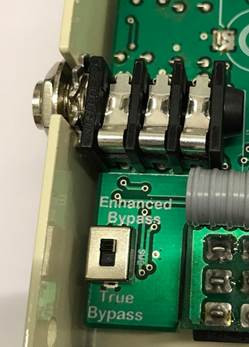The Fulltone OCD (Obsessive Compulsive Drive) has been a staple overdrive pedal on countless guitarists’ pedalboards since its introduction in 2004. Often discussed in forums and reviews as different “versions,” the OCD has actually seen subtle refinements over time, denoted by versions V1.0 through V1.8, all within the original Version 1 framework. Pedals with serial numbers 205811 and higher represent the latest iteration, sometimes referred to as “v2.01,” known for its less compressed character. This article dives into what makes the OCD a sought-after Ocd Guitar Effect and explores the enhancements in the V2 model.
What remains consistent in the OCD design is its pioneering use of Mosfets as clipping diodes. Furthermore, Fulltone innovatively configured these as “hard clippers connected to v-ref” instead of the conventional connection to ground. These technical choices are fundamental to the OCD’s renowned touch-sensitivity. This is what allows the pedal to respond dynamically to a player’s picking nuances, reacting distinctly to both gentle and aggressive playing. This design philosophy sets the OCD apart from many other overdrive pedals, a large percentage of which are often variations on the classic Tube Screamer circuit.
The OCD V2 introduces several key new features designed to further enhance its performance and adaptability in modern guitar setups.
A significant addition is the output buffer. This feature, active when the pedal is engaged in True-Bypass mode or always-on in Enhanced Bypass mode, isolates the OCD from the influence of subsequent effects in the signal chain. In today’s complex pedalboards, filled with numerous effects, loopers, and intricate signal routing, maintaining consistent tone can be challenging. The output buffer ensures that the OCD’s sound remains unaltered regardless of its position within such elaborate setups. Beyond signal chain benefits, this buffer also positively impacts the pedal’s core tone. By reducing the load on the hard-clipping stage, it contributes to increased sustain and richer overtone development.
Another crucial upgrade in the OCD V2 is the Class A configured discrete 2N5457 JFET input section. This enhancement raises the input impedance to 1 mega ohms, a substantial increase from the previous 330K. The result is a marked improvement in dynamics and interaction with guitars, whether equipped with single-coil or humbucker pickups. Players will experience a more responsive and nuanced connection between their instrument and the ocd guitar effect, unlocking a wider range of expressive possibilities.

The OCD V2 also features a new internal switch offering a choice between “Enhanced Bypass TM” and True-Bypass modes, both engineered to operate silently without any popping noises. Enhanced Bypass, a Fulltone innovation, addresses the drawbacks of traditional True-Bypass in complex pedalboard setups.
While True-Bypass was once considered the gold standard for preserving signal purity, the landscape of guitar effects has evolved dramatically. Modern pedalboards often contain ten or more pedals, introducing numerous cables and connections. This complexity can lead to significant signal degradation and tone loss, diminishing the direct, vibrant sound of a guitar plugged straight into a quality tube amplifier.
For decades, the pedal industry’s common solution to signal loss in complex setups has been the unity-gain buffered bypass, utilizing Field Effect Transistors (FETs) in a unity-gain buffer configuration, as popularized by brands like Boss and Ibanez.
The advantage of a unity-gain FET buffered bypass is its ability to mitigate signal loading caused by long cable runs and eliminate the audible “pop” when engaging or disengaging the effect.
However, unity-gain FET buffered bypass designs are not without their sonic compromises. Despite their prevalence, these buffers can subtly degrade the signal. Through rigorous testing with specialized equipment, it has been documented that each unity-gain FET buffer can actually reduce gain by 0.3 to 0.6 dB, particularly in the low-mid and bass frequencies. This subtle attenuation can result in a perceived “tinny” sound, as the high frequencies remain relatively unaffected while some low-end and midrange frequencies are diminished. Considering that typical buffered bypass circuits employ two FETs per pedal to manage the input and output paths, the cumulative gain loss can range from 1dB to 2dB per pedal in the chain.
Even more critically, the traditional unity-gain FET bypass can negatively impact dynamic pick response, even when the pedal is bypassed. This means it reduces the expressiveness and nuance achievable through varying picking力度 (picking dynamics), diminishing the difference between soft and hard playing. For many discerning players, this loss of dynamic responsiveness is a significant drawback.
Fulltone’s solution to these limitations is Enhanced Bypass. By configuring both switching FETs in Class-A, even with a minimal gain setting (0.3 to 0.6 dB in this case), the dynamics are not only preserved but amplified. This approach mirrors the desirable effect of vintage EP-3 Echoplexes and similar boosters, which are revered for their subtle yet transformative impact on guitar tone. The “magic” of these units lies in their Class-A FET preamp design. A Class-A FET preamp amplifies dynamics, providing an even wider expressive range than a direct guitar-to-amp connection. However, unlike EP-3 preamps which can introduce phase shifts, boost treble, and cut bass, Fulltone’s Enhanced Bypass maintains phase coherency and preserves the original EQ of the signal.
With the OCD V2’s Enhanced Bypass, this dynamic enhancement is present whether the pedal is engaged or bypassed. Simply having the OCD V2 in the signal chain, even when off, can revitalize the overall sound, injecting vibrancy and power into the entire rig.

The difference offered by Enhanced Bypass is significant and readily discernible. Guitarists are encouraged to experience the OCD V2 firsthand at their local dealer to fully appreciate the improvements. The Fulltone OCD V2 continues to refine the ocd guitar effect, offering enhanced clarity, dynamics, and adaptability for the modern guitarist.
